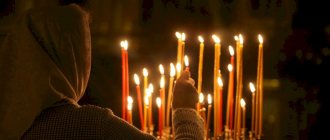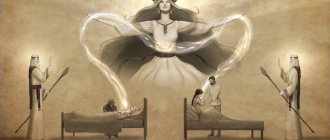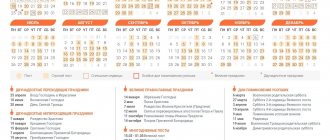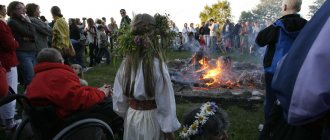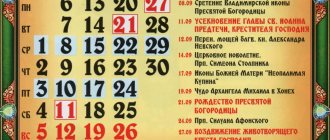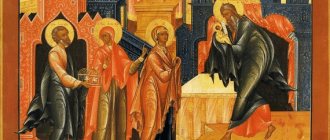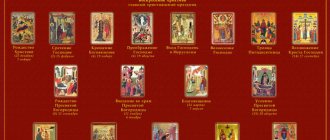The customs and traditions of the Russian people are inextricably linked with the calendar and church holidays . The famous Russian proverb says: “With God, every day is a holiday.” In fact, in the Orthodox calendar of holidays there are many memorable, significant days.
Icon of the Resurrection of Christ with the Passion Cycle and the Annual Menaion
In the Old Believer Church, the memory of saints glorified by the Church is celebrated every day. All church holidays are a veneration of the Higher and ethereal powers. Many church holidays are dedicated to special events, memories of biblical history, the appearance of miraculous icons, Old Testament and New Testament saints.
What are the Orthodox holidays?
On all holidays, the Charter prescribes a special divine service, usually ending with the Liturgy. The Church Charter (Typikon) provides for the gradation of all holidays according to the degree of solemnity of their services, which is recorded by special signs of the holidays of the month. The first evidence of this practice comes at the end of the 11th century. Rev. Nikon Montenegrin. He describes a system of 3 ranks of holidays: great, medium and small. Easter stands out first of all - the most important holiday; in the canon of the holiday, Easter is called “a holiday, a holiday and a triumph, a triumph.” Then follow the Great Holidays (including 12 twelve and non-twelfths), followed by the middle and small ones . The triumph of the Resurrection of Christ is also remembered on every Sunday day (week).
The twelfth and great holidays in the calendar are indicated by a red cross in a circle, the middle ones - by a red cross without a circle, and the small ones - by three dots in a semicircle. In con. XIX century A new system of perceptive signs for the holidays of the month has appeared, recorded, for example, in the currently popular “Key to the Church Rules” by N. S. Syrnikov and other Old Believer and Edinoverie publications and manuscripts.
All church holidays are distributed within two annual cycles - fixed (minaine) and moving (triode). Celebrations of the fixed cycle are strictly fixed only by the dates of the month (for dates of the Julian calendar in relation to the modern civil calendar, an amendment is necessary: n - 13 days). The holidays of the moving cycle are fixed only by day of the week, being strictly correlated with the date of Easter, which is the starting point for the entire moving annual cycle. Easter and the twelve feasts (as well as some others) have a pre-celebration, post-celebration and giving.
By theme, holidays are divided into the Lord's (in honor of the Savior), the Mother of God and the feasts of saints (and councils of saints). Saints mean both people (pleasers of God) and angels. According to the time of celebration, holidays are divided into moving (transitionable) and stationary. Depending on the location, celebrations are divided into general, celebrated equally solemnly in all churches, and local. The latter include the so-called patronal (temple) holidays or holidays in honor of locally revered icons or saints. The patronal feast of any church (whose name it bears) is equated for it in the liturgical aspect to great holidays. The same degree of solemnity may be inherent in “locally revered” holidays.
Replenishing the Orthodox calendar is a long and continuous process, because canonization and veneration of new saints periodically take place in the Old Believers.
Religious traditions of Christians
In most religions, there are special ritual actions - sacraments, through which God's saving grace is invisibly transmitted to a person. Initially, in the traditions of the Christian faith there were two sacraments - baptism and communion.
In 1279, at the Ecumenical Council in Lyon, five more church rites were included in the list of sacraments. They are recognized by the Orthodox and Catholic churches; Protestants interpret church sacraments as a simple religious ritual.
- Baptism is a three-time immersion in the water of the holy font (or dousing with water), accompanied by the reading of prayers. The ritual is performed as a sign of a person’s involvement in the Church, and is conducted by a clergyman. A baptized person wears a cross around his neck and has the right to take part in church ceremonies.
- Communion (Eucharist) - communion with Christ through the consumption of consecrated bread and wine in a special way.
- Repentance (confession) is a confession of committed sins before a priest who has the right to absolve sins on behalf of the Lord. It is believed that self-reproof and the determination not to repeat sins bestow God's mercy.
- Confirmation is a sacrament performed on a believer, usually after Baptism. A person receives forgiveness of sins and the “seal of the gift of the Holy Spirit” on his forehead. During the ceremony, the priest anoints certain parts of the believer’s body with a composition of fragrant oils - consecrated myrrh.
- Blessing of oil is a sacrament performed on the sick, anointing the body with consecrated oil. It is believed that such a ritual invokes the grace of God and promotes healing. In Christianity, there is also the rite of Anointing, which consists of applying the sign of the cross with oil to the forehead of the believer. This ritual is not a Sacrament.
- Priesthood is a rite of passage to serve in the church as a deacon, presbyter or bishop (bishop). Ordination to the rank of clergy is performed by a bishop and gives the right to conduct church sacraments and rituals.
- Wedding is the main ritual of the Christian wedding ceremony. The union of a man and a woman blessed by the church seals marriage in heaven. When Christians get married, they take a vow of fidelity to Christ and each other. Christian family traditions are based on compliance with the rules bequeathed by the Savior: to maintain moral purity, to live in love and harmony.
List of Orthodox holidays and dates
Below is a list of the most revered Orthodox holidays, indicating dates according to the new style.
Easter and Twelfth Feasts:
- Easter is a moving holiday;
- Nativity of the Blessed Virgin Mary - September 21;
- Exaltation of the Holy Cross - September 27;
- Presentation of the Blessed Virgin Mary into the temple - December 4;
- Christmas - January 7;
- Epiphany - January 19;
- Presentation of the Lord - February 15;
- Annunciation of the Blessed Virgin Mary - April 7;
- Palm Sunday is the closest Sunday before Easter, a moving holiday;
- The Ascension of the Lord is the 40th day after Easter, always on Thursday, a moving holiday;
- Feast of the Holy Trinity (Pentecost) - the 50th day after Easter, always on Sunday, a moving holiday;
- Transfiguration of the Lord - August 19;
- Dormition of the Virgin Mary - August 28.
Great Holidays:
- Holy Apostle John the Theologian - October 9 and May 21;
- Nativity of John the Baptist - July 7;
- Memory of the Holy Apostles Peter and Paul - July 12;
- Beheading of John the Baptist - September 11.
Middle holidays:
- New Year - September 14;
- Appearance of the Burning Bush Icon of the Mother of God - September 17;
- Memory of St. Sergius of Radonezh - October 8;
- Intercession of the Blessed Virgin Mary - October 14;
- Holidays in honor of the Kazan Icon of the Blessed Virgin Mary - November 4;
- Feast of the appearance of the icon of the Mother of God “Joy to all who mourn” (bezpopovtsy do not have this holiday) - November 6;
- Memory of the Great Martyr Demetrius of Thessalonica - November 8;
- Cathedral of the Archangel Michael - November 21;
- Commemoration of St. John Chrysostom - November 26;
- Sign of the Mother of God in Veliky Novgorod - December 10;
- Memory of St. Nicholas, Miracle Worker of Myra-Lycia - December 19 and May 22;
- Cathedral of the Blessed Virgin Mary - January 8;
- Circumcision of the Lord - January 14;
- Memory of St. Basil the Great - January 14;
- Cathedral of John the Baptist - January 20;
- Memory of St. Gregory the Theologian - February 7;
- The memory of three saints Basil the Great, Gregory the Theologian and John Chrysostom - February 12;
- The holiday in honor of the first and second finding of the head of John the Baptist is March 9 (March 8 in a leap year);
- Memory of the 40 Martyrs of Sebaste - March 22;
- Commemoration of the appearance of the Theodore Icon of the Mother of God - March 27; August 29; in the second week of Lent “according to the charter of the Assumption Cathedral of the Moscow Kremlin”;
- Praise of the Most Holy Theotokos - Saturday of the fifth week of Lent;
- Lazarus Saturday is a moving holiday on the eve of Palm Sunday, 8 days before Easter;
- Memory of the Great Martyr George - May 6;
- Mid-Pentecost is a moving feast on Wednesday, three and a half weeks after Easter;
- The celebration of Easter is a moving holiday on the 40th day after Easter, on the eve of the Ascension of the Lord;
- Celebration of the presentation of the Vladimir Icon of the Most Holy Theotokos - June 3, July 6, September 8;
- The third discovery of the head of John the Baptist - June 7;
- Appearance of the Tikhvin Icon of the Blessed Virgin Mary - July 9;
- Position of the Robe of the Lord - July 23;
- Memory of the Prophet Elijah - August 2;
- Appearance of the icon of the Most Holy Theotokos Hodegetria of Smolensk - August 10;
- Origin of the Holy Cross - August 14;
- Tolga Icon of the Blessed Virgin Mary - August 21;
- Transfer of the Image Not Made by Hands - August 29;
- Don Icon of the Blessed Virgin Mary - September 1.
Small holidays:
- Venerable Alexander Svirsky
- John (Ilya), Archbishop of Novgorod
- Holy princes of Yaroslavl Theodore, David and Constantine
- Holy Fathers Joachim and Anna
- Holy martyrs Faith, Hope, Love and their mother Sophia
- Venerable Anna Kashinskaya
- Holy Martyrs Cyprian and Justina
- Holy wonderworkers and unmercenaries Kozma and Damian
- Venerable Varlaam of Khutyn
- Blessed Maxim, Fool for Christ's sake
- Holy Blessed Prince Alexander Nevsky
- Holy Great Martyr Catherine
- Holy Great Martyr Barbara
- Venerable Sophia of Suzdal
- Holy Martyr Tatiana of Rome
- Reverend Maxim the Greek
- Venerable Nikita Stylite
- Venerable Paphnutius Borovsky
- Venerable Demetrius of Prilutsky
- Holy Blessed Prince Daniel of Moscow
- Venerable Theodosius of Pechersk
- Venerable Neil of Sorsky
- Venerable Euphrosyne of Polotsk
- Saint Leonty of Rostov
- Saint Nikita, Bishop of Novgorod
- Venerable Dionysius Glushitsky
- Venerable Kirill Belozersky
- Venerable Paisius the Great
- Saints Peter and Fevronia
- Holy Princess Olga
- Venerable Stefan Makhrishchsky
- Holy Prince Vladimir
- Holy Princes Boris and Gleb
- Blessed Basil of Moscow
- Venerable Zosima and Savvaty of Solovetsky
- Blessed Lavrenty of Kaluga
Exaltation of the Holy Cross
This holiday is associated with one of the main Christian symbols - the cross on which the Son of God passed the test of death. And its appearance was facilitated by the Byzantine Empress Helen in the middle of the 4th century. Already at a fairly advanced age (according to historians, she was about 80 years old), the mother of Emperor Constantine decides to go to Jerusalem in search of lost Christian relics. As a result of excavations on Mount Golgotha, they found not only a cross, but also a cave in which Christ was buried.
The date of celebration was set in September 335 - after the Church of the Resurrection of Christ was consecrated in Jerusalem. The Orthodox world celebrates September 27 by observing strict fasting and not engaging in hard work. People also believe that it is from this day that birds begin to fly south, and snakes begin to crawl into holes for the winter.
Church holidays and state holidays
Religious holidays, originating in the distant past, despite their “public” nature and popularity among the people, leave in the soul a feeling of some kind of intimate joy, so characteristic of personal holidays and completely unusual for state, civil holidays. In Russia, until 1925, Easter and all the twelfth holidays, Orthodox in their essence, were also state and civil holidays. At present, when the equality of religions and their independence from the state has been proclaimed in our state, only the Nativity of Christ is declared a day off and is celebrated as a public holiday. This, of course, does not make Christmas the main Orthodox holiday (which Christmas, by the way, is for other non-Orthodox Christians). The holiday of holidays for Orthodox Old Believers was and remains Easter, the Holy Resurrection of Christ. And Easter is celebrated in Russia much more widely than other holidays. But, according to tradition, it is always celebrated on Sunday, so it did not become a public holiday.
In 2005, the Russian national holiday National Unity Day was established on November 4. On this day, Orthodox Christians celebrate the appearance of the Kazan Icon of the Blessed Virgin Mary, thanks to whose intercession, according to legend, the militia under the leadership of Kuzma Minin and Dmitry Pozharsky won a victory over the Poles in 1612. In 1649, by decree of Tsar Alexei Mikhailovich, the church holiday of the Kazan Icon of the Mother of God acquired state status. It was celebrated for three centuries, until 1917. With the advent of Soviet power, the tradition of celebrating the liberation of Moscow was interrupted, and then resumed again a little over 10 years ago.
It seems that every possible support for the tradition of celebrating ancient religious holidays helps us to recognize ourselves as part of the people, part of a great culture. Makes us think about eternal values, which, however, often do not seem worthy of attention to us while we are young, but which inevitably attract us as we grow older. It helps to resist the wave of all the dirt that television and other media pour into the souls of people, especially young people.
The main canons of the direction in Christianity
Christianity as a religion originated in the 1st century among Palestinian Jews and quickly spread among the Greco-Romans and other ethnic groups. The uniqueness of this religion is that it assumes not only the eternity of the human soul, but also the resurrection of the body after the afterlife. True, not all resurrected people will be worthy of staying in the Kingdom of Heaven.
The main directions in Christianity today are considered to be Catholicism, Orthodoxy and Protestantism. And although the ancient Christian religious traditions and the main dogmas of Christianity - the belief in the coming resurrection and the divine essence of Jesus Christ - are common to them, each of the directions has its own peculiarities of doctrine and differences in the interpretation of some religious canons.
The fundamental difference between the Catholic and Orthodox Churches is the understanding of the unity of the Church. For the Orthodox, it is enough to share one faith and sacraments; they consider each local Church of the episcopate to be the embodiment of the Universal Church; Catholics, in addition to this, see the need for a unified leadership of all churches, which is exercised by the supreme ruler of the Holy See - the Pope.
The features that distinguish the Protestant Church from the Catholic and Orthodox Church are more numerous. Thus, Protestants recognize the Bible, but reject the Holy Tradition of the Church and church rites. It is not customary for them to pray for the dead, believing that thanks to their prayers the Lord will ease their posthumous fate. Protestants deny fasting and believe that recognizing Jesus Christ as God is already enough for salvation, and no works are needed for this. Whereas Catholics and Orthodox Christians claim that it is necessary to prove one’s faith through deeds, fulfilling the commandments of the Father.
Transfiguration
The Feast of the Transfiguration is associated with a small episode from the life of Christ. Taking with him three disciples - James, John and Peter - Jesus ascended Mount Tabor for conversations and prayers. But as soon as they reached the top, a miracle happened - Jesus ascended above the earth, his clothes became white, and his face shone like the sun. Next to him, the images of the Old Testament prophets Moses and Elijah appeared, and the voice of God was heard from heaven, announcing a son.
The Transfiguration is celebrated on August 19. This great Orthodox holiday in folk tradition is called the Apple Savior (second after Honey). It was believed that from this day autumn begins to come into its own. Many customs of this day are associated with the harvest of apples and fruits in general - before the Savior, the fruits were considered unripe. Ideally, the harvest should have been blessed in the church. Then apples could be consumed without restrictions.
Dormition of the Virgin Mary
The celebration of the Dormition of the Virgin Mary is associated with the end of the earthly life of the Virgin Mary and the ascension of her soul and body to heaven. The word “dormition” can be interpreted more as “sleep” than “death” - in this regard, the name of the holiday reflects the attitude of Christianity towards death as a transition to another world and testifies to the divine nature of Mary herself.
This great Orthodox holiday is celebrated on August 28, although it is not known for sure in what year and on what day the Virgin Mary passed away into another world. In folk tradition, this day is called Obzhinki - it is associated with the end of the harvest.
Nativity
Of all twelve, the great Orthodox holiday of Christmas is considered the most significant. In the Western tradition, it is customary to celebrate it on December 25, but in our country it is celebrated on January 7.
The birth of Jesus took place in the city of Bethlehem, Joseph's hometown. He arrived here with the pregnant Maria, but there was no room for them in the hotel. The travelers had to camp in a cave. When Mary felt the birth approaching, Joseph hurried to find a midwife. He managed to find a woman named Salome, and together they went back to the cave. The first thing they saw in the cave was a bright light filling the entire space. Gradually the light faded away - and Mary appeared with a baby sitting in her arms. At this time, a star of extraordinary brightness rose over Bethlehem, notifying the world of the arrival of the Son of God.
It is believed that every great Orthodox holiday gives birth to kindness in the heart, but Christmas especially. On Christmas Eve, it is customary for the whole family to gather around the festive table - in folk tradition, there should be twelve dishes on it.
Historians believe that it is not known for certain at what time of year Jesus was born. It is believed that the date of the great Orthodox holiday of Christmas is connected with more ancient holidays dedicated to the winter solstice (December 21 or 22). This holiday is preceded by a forty-day fast, starting on November 27.
Presentation of the Blessed Virgin Mary into the Temple
The Orthodox holiday of Entry into the Temple is celebrated on December 4th. It is dedicated to an episode from the life of the Virgin Mary - at the age of three, pious parents brought her to the Jerusalem Temple to fulfill God's covenant - to devote the life of their daughter to God. In all interpretations of this story, they say that little Mary entered the temple with unusual confidence, as if she already knew that she would play a great role in this religion. Maria never returned home to her parents - she lived in the temple until she was 12 years old, until the angel Gabriel brought her news of the extraordinary fate that had been granted to her.
In folk tradition, this holiday is called Introduction. It was associated with the arrival of winter - it was from this day that winter festivities and sleigh rides began. It was also worth forgetting about field work until spring - the peasants believed that it was better not to disturb the land after the Introduction.
Day of the Holy Trinity
Another ten days pass after the Ascension and fifty after Easter, when the Orthodox world celebrates the next great Orthodox holiday. Simply put, it is also called Trinity, Pentecost. The event that led to the appearance of this holiday was the descent of the Holy Spirit on the apostles. When all twelve were assembled, a gust of wind suddenly came and enveloped the apostles in flames. The Holy Spirit declared itself so clearly. From that day on, Jesus’ disciples gained the ability to understand hitherto unknown languages and dialects, and most importantly, to speak them. This blessing was given to them in order to spread the word of God throughout the world, so the apostles went to preach throughout the countries.
In folk tradition, Trinity completed the series of spring holidays - after it the summer season began. They prepared thoroughly for this holiday - a few days before it, housewives cleaned the house, trying to get rid of unnecessary things, and the garden and vegetable garden were cleared of weeds. They tried to decorate their home with bunches of herbs and flowers, as well as tree branches - it was believed that this would bring good luck and prosperity to all its inhabitants. In the morning they went to church for services, and in the evening the festivities began. Young people these days were instructed to be careful - after all, mermaids and Mavkas came out of forests and fields to lure guys into their nets.
